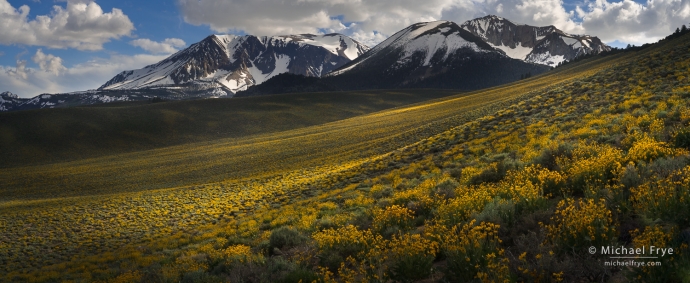
Fields of arrowleaf balsamroot below Sierra peaks, Inyo NF, California. It was a bit of a grunt to climb up this hill through the sagebrush, but I thought this higher vantage point would allow me to see a succession of layers from foreground to middle ground to background, which could add more depth to the image. The dappled light and clouds were perfect complements to the scene. This is a stitched panorama (three shots), made quickly to capture fleeting light. 50mm, 1/125 sec. at f/16, ISO 100.
Tioga Pass through Yosemite finally opened yesterday, July 22nd. That’s the latest opening date ever – by far. The previous record was July 8th, way back in 1933, before the road was even paved. In 1938, the year after it was paved, Tioga Road opened on July 5th. But since 1938 it’s always opened by the end of June, except for 1998, when it opened July 1st. Even in the prodigious snow year of 1983 it opened on June 30th.
An exceptional set of circumstances conspired to make this year’s opening so late. First, there was a lot of snow. There’s some debate about whether this was a record year for snowfall in the Sierra; it’s actually a hard thing to measure, as there are a lot of variables. But it was certainly one of the snowiest years on record.
But it wasn’t just the amount of snow that delayed the opening. Cool temperatures in spring and early summer meant that little snow melted in April, May, and early June, which are normally the months of peak melting and runoff. There was also high avalanche danger at Olmsted Point; ever since snowplow operator Barry Hance died in an avalanche there in 1995, crews have been understandably cautious in that area. When the park service finally did get most of the road plowed, they discovered that sections of the road had been damaged during the winter and needed repairs. (There’s still only one lane open near Olmsted Point, with traffic controls and delays.)
This year our workshop in the Yosemite high country was scheduled to start on July 10th. I knew there was a lot of snow in the mountains, yet felt pretty confident the Tioga Road would open in time for the workshop, since it had never opened later than July 1st since 1938! But as the workshop approached, and it became apparent that the pass wouldn’t open, we had to adapt. And sometimes that’s a good thing.
Knowing that we wouldn’t be able to get to the Yosemite high country during the workshop, we headed over early (via Sonora Pass) to our base in Lee Vining (near Mono Lake) to scout for alternative locations. And of course we found plenty of them, because the eastern Sierra is an exceptionally beautiful area. And we also got a big assist from Tim Aston, my assistant for the workshop, who lives in Mammoth and knows the area well.
Best of all, we found lots of wildflowers. There were flowers blooming everywhere, even in the sagebrush habitats in the high desert, even in July. All that late-melting winter snow left plenty of moisture in the soil, which the flowers apparently loved.
So while we weren’t able to go to some of the places we normally go during the workshop, we had a great time on the eastern side of the mountains. We were still able to photograph cascading mountain creeks, and alpine lakes with snowy mountain backdrops. And we got to photograph lots of wildflowers, in places I’d never seen flowers before, which was great fun.
Here’s a small collection of my flower photos from this summer in the eastern Sierra. A couple of these were made in June, prior to our Starry Skies Adventure workshop, but most were made either during or just prior to our July Range of Light workshop. It’s been a spectacular year for wildflowers in California, and it’s not over; in the highest mountains the bloom should continue into August or even September.
— Michael Frye
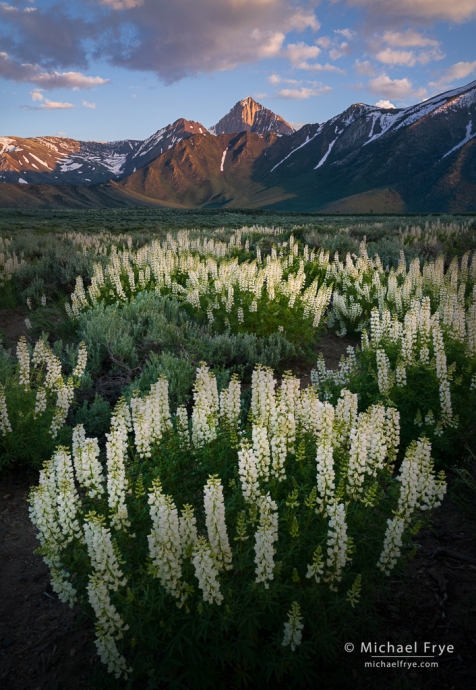
White lupines and Sierra Nevada peaks, Calfornia. I’d never seen such an extensive display of white lupines before – and set below some beautiful peaks to boot. 32mm, 1/20 sec. at f/16, ISO 100.
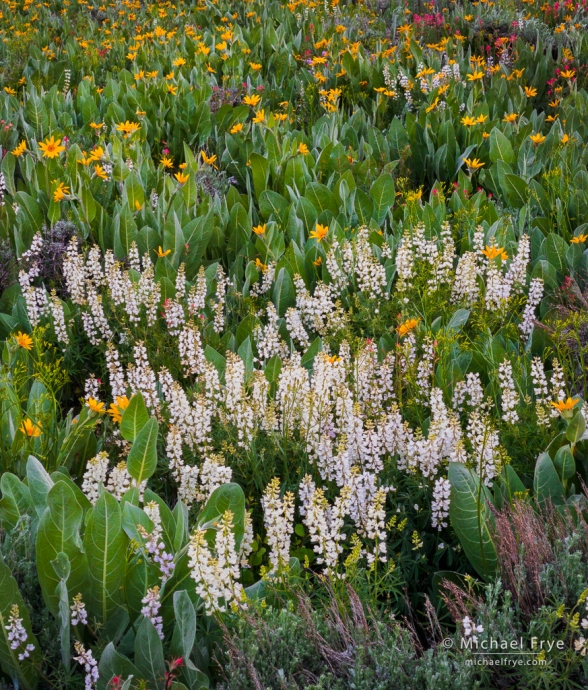
White lupines, mule’s ears, and paintbrush, Inyo NF, California. The wind was blowing too hard to have any hope of focus-stacking and getting all these flowers in focus with my big camera, but it was easy to get it all in focus with the small sensor in my iPhone. iPhone 12 Pro Max with 2.5x lens (7.5mm), 1/120 sec. at f/2.2, ISO 20, shot in raw in the Lightroom app.
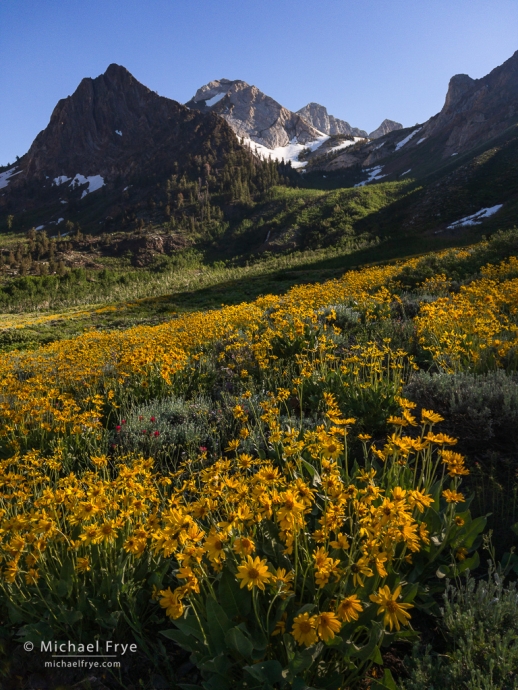
Peaks and wildflowers, Inyo NF, California. Another iPhone image, made on a scouting trip where I didn’t want to lug my big camera. iPhone 12 Pro Max with 1x lens (5.1mm), 1/2500 sec. at f/1.6, ISO 32, shot in raw in the Lightroom app.
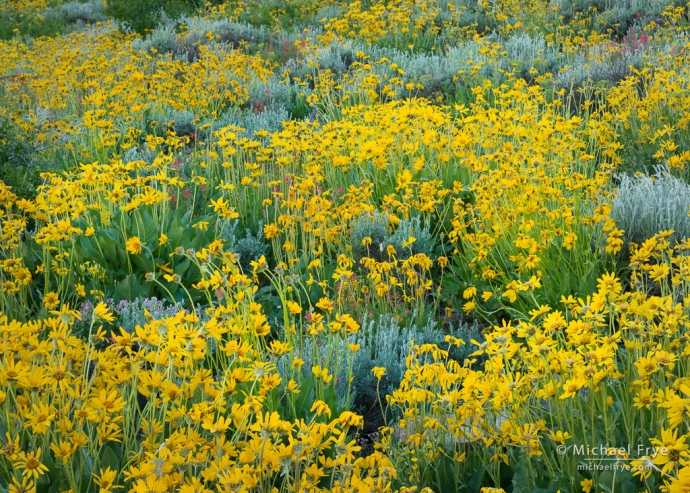
Arrowleaf balsamroot, sagebrush, and paintbrush, Inyo NF, California. Here the wind died just long enough to capture a focus-stacking sequence. 84mm, 1/15 sec. at f/16, ISO 320, three focus-stacked frames blended with Helicon Focus.
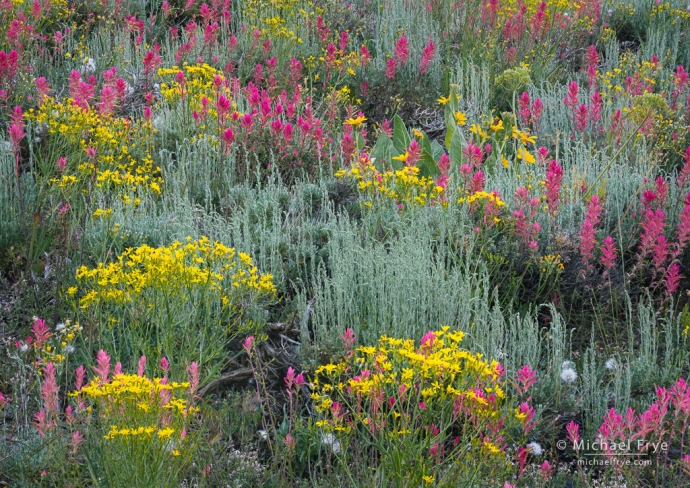
Wildflowers, Inyo NF, California. Another focus-stack. 145mm, 1/15 sec. at f/16, ISO 320, four focus-stacked frames blended with Helicon Focus.
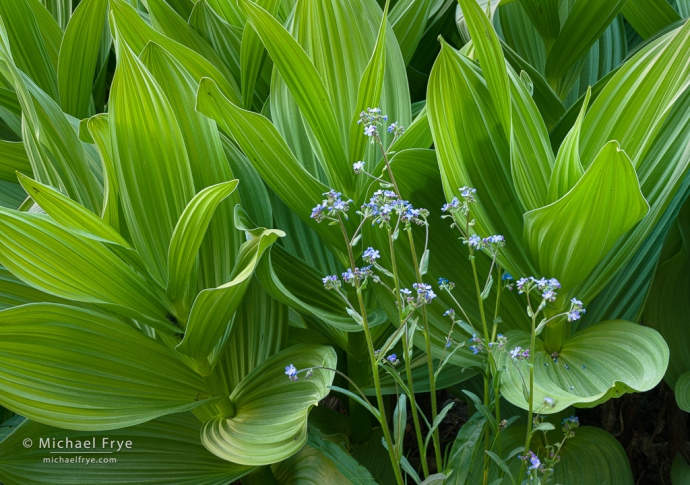
Corn lilies and forget-me-nots, Toiyabe NF, California. This time it was very calm, allowing for a long focus stack. 118mm, 0.7 seconds at f/16, ISO 100, five focus-stacked frames blended with Helicon Focus.
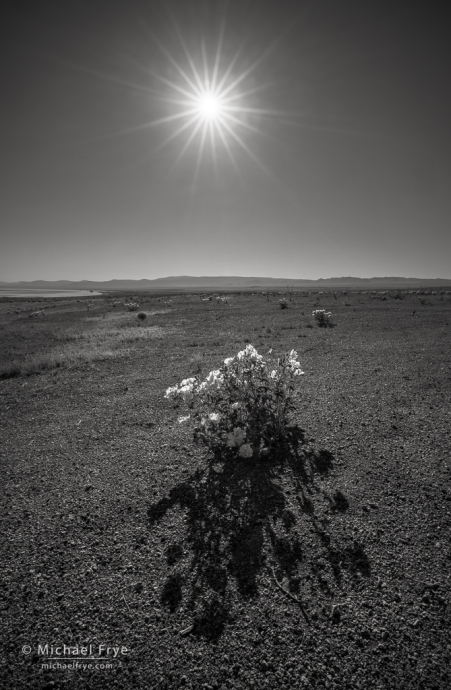
Prickly poppies in a burned area near Mono Lake, California. When I saw these scattered prickly poppies blooming in a barren area (from the Beach Fire in 2020), I immediately recognized the potential to make a photograph that told a story about growth and rejuvenation. I thought including the sun itself would add to that story, so I used a wide-angle lens to include the sun, shrub, and shadow. 20mm, five auto-bracketed frames with shutter speeds ranging from 1/8 to 1/2000 sec., f/16, ISO 100, blended with Lightroom’s HDR Merge.
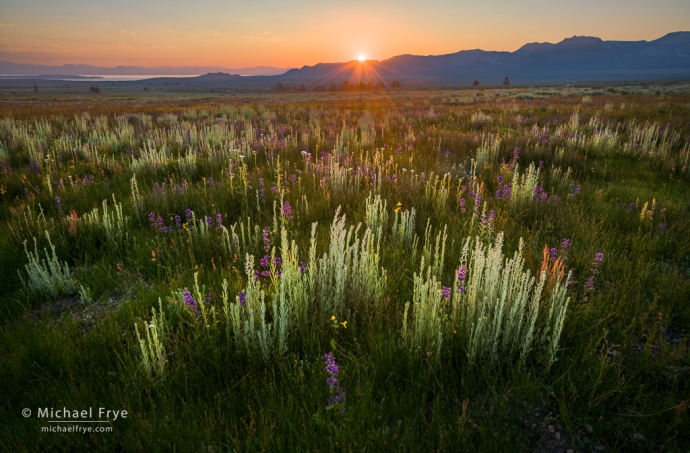
Sage and wildflowers at sunrise, eastern Sierra Nevada, California. Another high-contrast scene that required bracketing and blending exposures to get detail in highlights and shadows. 22mm, five auto-bracketed frames with shutter speeds ranging from 1/3 to 1/750 sec., f/16, ISO 400, blended with Lightroom’s HDR Merge.
Related Posts: Wind Clouds; Over Tioga Pass; Lightning Storm at Mono Lake; Focus-Stacking Season
Michael Frye is a professional photographer specializing in landscapes and nature. He is the author or principal photographer of The Photographer’s Guide to Yosemite, Yosemite Meditations, Yosemite Meditations for Women, Yosemite Meditations for Adventurers, and Digital Landscape Photography: In the Footsteps of Ansel Adams and the Great Masters. He has also written three eBooks: Light & Land: Landscapes in the Digital Darkroom, Exposure for Outdoor Photography, and Landscapes in Lightroom: The Essential Step-by-Step Guide. Michael has written numerous magazine articles on the art and technique of photography, and his images have been published in over thirty countries around the world. Michael has lived either in or near Yosemite National Park since 1983, currently residing just outside the park in Mariposa, California.









The rest of the series is gorgeous too! Thanks for sharing, Michael.
Thanks again Vivienne!
Stunning! What a beautiful series.
Thanks so much Stacy!
Amazing to see such blooming this late. Great shots. What where the temps like during the day? And to think in a little more than 2 months the aspen will be in fall color. Are you using a 16-35mm for your wide angle photos?
Thanks Ed! Temps were low to mid 80s in Lee Vining, but that was then. I used a 16-35 zoom for some of the wide-angle images. The photo of the prickly poppy was made with a 20mm prime.
Beautiful photos Michael. Lovely to see all the wildflowers. The corn lilies are very sculptural. It reminded me of when I was lucky enough to see many beautiful wildflowers at Mt Rainier one September when we were visiting from the UK. Thank you for providing information on Tioga Pass, very interesting. Always enjoy receiving your emails.
Thanks very much Jane! Yes, corn lilies have great structure and design, which makes them interesting photo subjects. Glad you got to see wildflowers at Mt. Ranier; one of these days I’ll get up there for flower season.
Such beautiful shots. Thanks for sharing your process – makes me want to get to the Sierra’s and see some of these myself. Early mornings and late day shoots capture natures magic.
Beautiful images, Michael, thanks! It has really been a great year for wildflowers in the Sierra! Our annual dads and kids campout begins next Friday at the Clark Fork Campground. I’m heading down Hwy 395 on Wednesday and over Sonora Pass. I’ll have a couple days for photography before everyone arrives and am hopeful to find some wildflowers near the summit. Sounds like your summer is going well. Best wishes.
Thanks Bob! Hope you find some flowers, and have a great time at the campout.
Michael: I am curious how you are adjusting your focus for your stacks… are you using touch focus on the LCD, refocusing manually, or using some form of automated focus bracketing?
I usually focus manually. I don’t have touch focus on my camera, but sometimes use autofocus for focus stacking and move the autofocus point with the dial on the back.
Thanks Michael. I love your wildflower shots… for some reason I have trouble composing wildflower shots so it’s nice to see some examples with very different focal lengths. Looking forward to the high-contrast processing webinar!
Thanks Glenn. With wide-angle lenses I’m trying to find a compelling foreground arrangement to couple with something compelling the background. With telephotos I’m usually trying to fill the frame with a pattern.